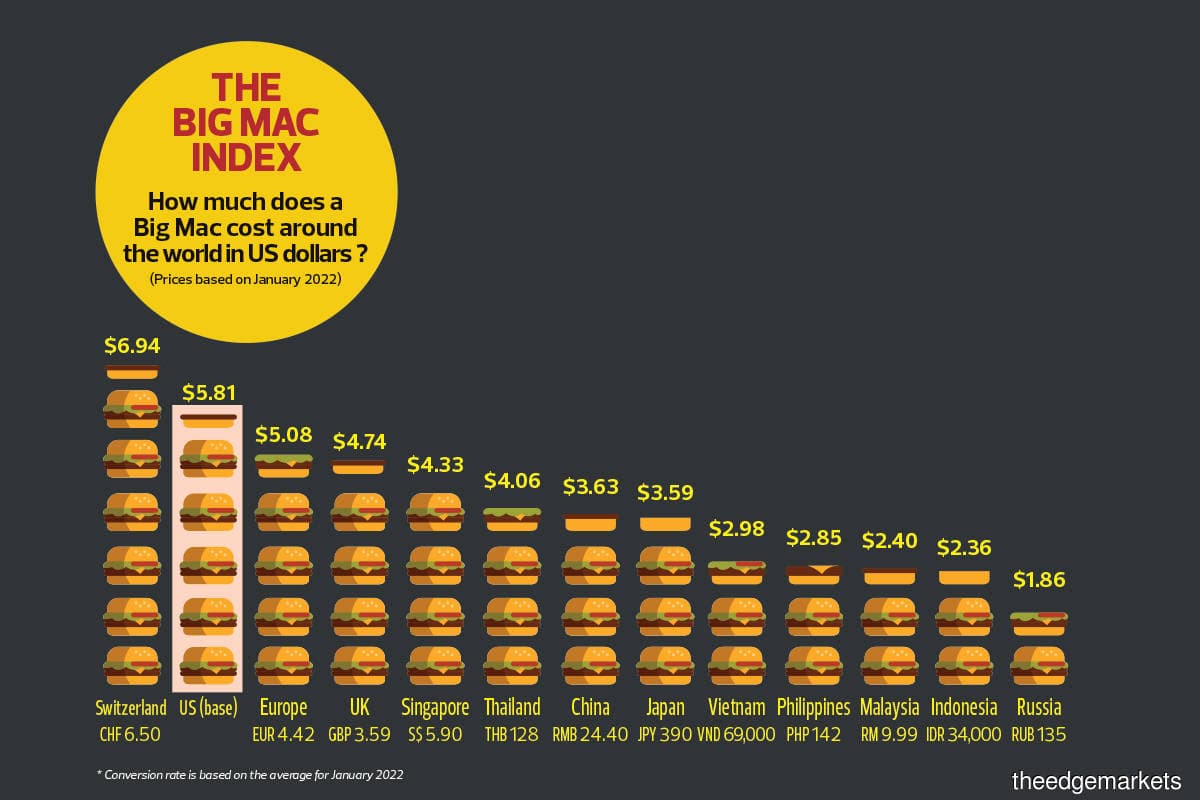
This article first appeared in The Edge Malaysia Weekly on July 18, 2022 - July 24, 2022
THE next time you take a bite out of a McDonald’s Big Mac in Malaysia, which costs RM10, remember that you are getting it at a discount of 58.9% compared with someone who purchased the fast food chain’s iconic burger in the US for US$5.81.
Well, it is only considered a discount if you’re earning an income in US dollars.
In other words, the ringgit is undervalued by 58.9% compared to the greenback, according to The Economist’s Big Mac Index.
It also means that the ringgit will get you fewer things if you were to go to the US for a holiday, or purchase an item online in US dollars.
The comparison is made with the most recent set of data available as at January 2022.
At present, the exchange rate is 4.45 ringgit to the greenback. The local currency has depreciated about 6% in a period of one year. A year ago, US$1 was equivalent to RM4.20.
The Big Mac Index — based on the theory of purchasing-power parity — compares the price of Big Macs in major currencies, in most cases US dollar terms, across countries and is meant as a light-hearted guide on whether currencies are at their “correct” level.
Shockingly or not, the ringgit is one of the most undervalued currencies on the index, ranking fourth from the bottom out of the 56 countries on it.
The most undervalued currency on the index was the Russian rouble, by 70%. Meanwhile, the most overvalued currency compared to the US dollar, based on the index, is the Swiss franc, by about 20.2%.
Among the Southeast Asian countries, Malaysia does not have the most undervalued currency. Indonesia ranks just below, with the rupiah undervalued by 59.3% compared to the US dollar.
The least undervalued currency in Southeast Asia is the Singapore dollar, which is only 24.9% undervalued against the US dollar, followed by Thailand’s baht at 33.8%.
Meanwhile, the currencies of other Southeast Asian countries are also severely undervalued based on the index, with the Vietnamese dong at a 47.6% discount to the US dollar, and the Philippines peso at 52.1%.
However, if we were to look back at the data in pre-pandemic days — using January 2019 as a benchmark — it seems that most Southeast Asian currencies fared better.
Back then, a Big Mac was slightly cheaper in the US at US$5.58. Similarly, it cost less in Malaysia as well, at RM9.05.
However, Malaysia seems to be an exception, apart from Vietnam, in Southeast Asia, with the ringgit seemingly even more undervalued in January 2019 at a discount of 60.6% to the US dollar.
The Vietnamese dong was slightly worse off in 2019, undervalued by 49.8% compared with 47.6% in January 2022.
However, other currencies like the Singapore dollar (undervalued by 23.3%), Indonesian rupiah (undervalued by 58%), Philippines peso (undervalued by 52%) and Thai baht (undervalued by 33.4%) all fared slightly better in 2019.
That being said, the Big Mac Index is merely an informal measure of purchasing power parity. It does not take into consideration the input cost of making a Big Mac, be it raw material costs, labour cost or rental cost of a franchise licence.
Many say that this could affect the price of the Big Mac, thus rendering it a less accurate comparison to the US version of a Big Mac.
Nevertheless, as the inventors of the index put it: “Burgernomics (or the Big Mac Index) was never intended as a precise gauge of currency misalignment, but merely a tool to make exchange-rate theory more digestible.”
Save by subscribing to us for your print and/or digital copy.
P/S: The Edge is also available on Apple's AppStore and Androids' Google Play.